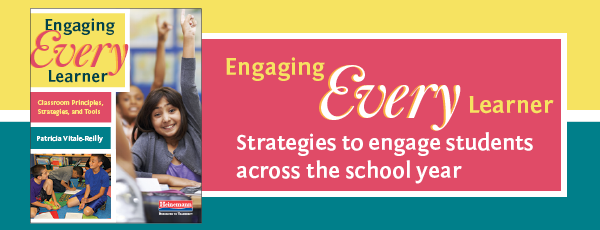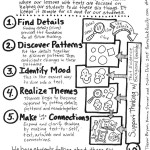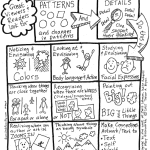Ensuring that our students grow up to be excellent readers and writers is one of our most important jobs as educators. We, at Four O’Clock Faculty, are always excited to learn from literacy experts. One of those experts is Patricia Vitale-Reilly, who recently released the book, Engaging Every Learner.
We are happy to have Patricia joining us today to share her insight.
5 Questions with… Patricia Vitale-Reilly
1. What do you most want your students to take with them from your classroom, school or district?
I want the teachers, administrators, and students with whom I work to understand that literacy instruction is not just about content but about how we authentically communicate in the world. Literacy instruction is about reading, writing, speaking, and listening and is at the true heart of all teaching and learning. When we are making decisions about what to teach, what to read, what materials to use, and how to structure our time in the classroom, we need to consider what will engage our students in thinking, doing, reading, writing, talking, and collaborating. As teachers, we need to understand that we are not just covering content, and our students need to understand that they are stakeholders in their learning.
In the April 2015 Education Update (ASCD), author Laura Varlas quotes Grant Wiggins in her article titled, “Writing the Master Plan.” She writes, “Planning, he claims, shouldn’t be about what book you are reading, but ‘how students are different when they’re finished reading it.’”
How students are changed through instruction – that is what I want for all teachers, administrators, and students to take with them. For me, I believe that students are changed in two ways: they are changed as readers and writers, speakers and listeners, but they are also changed as people. That is what literacy instruction can and will do when it is taught, practiced, assessed, and learned in authentic and meaningful ways. That means that as teachers we plan experiences that are authentic — we read, write, speak and listen in the real world. We read real texts, chosen with and by students; we see writing as a tool for communication and we publish for real audiences, writing articles, blogs, stories, public service announcements, and subway poetry; we share our thinking about books and topics through a variety of media including having real-time collaborative conversations with our peers, Skype sessions with students from around the world, and post and comment on a class VoiceThread or Wiki that the larger school and community can participate in.
2. What are the most rewarding and/or frustrating aspects of education?
Considering the current tide in education, the most frustrating aspect to me is the conundrum of standardized testing. As educators on the ground, we need to continue to speak up about what is important and appropriate in education and bring assessment to a better place—a place where assessments are relevant, timely, appropriate, connected to instruction, and that lead us to the practices we know work best with learners.
Always what is most rewarding is work with students. Even in my current role as consultant, the best parts of my day and week are the times I spend in the many classrooms I get to work in. I believe that students are our greatest teachers. They help me to keep the joy and enjoyment in teaching.
3. What advice would you give to young teachers?
The advice I would give to young teachers is to stick with it. Teaching can be hard, and even grueling and frustrating at times, but it can also be the most inspiring and rewarding profession. I truly believe that. To make teaching a rewarding and inspiring profession, I always pass along three pieces of advice to young teachers.
First, I suggest that teachers find a professional posse. That is my term for the group of professionals that will laugh with you, cry with you, and learn with you! My professional posse has certainly evolved over the years, but in some ways has stayed the same, too. In your professional posse, it is good to imagine three groups: mentors, peers, and distant friends.
Mentors can be an administrator, coach, or even an experienced teacher. For me, it was both my principal when I was teaching fourth grade in New Jersey, and my literacy coach. These women had a profound impact on my professional learning. Peers- peers are your colleagues in your building, but also your colleagues from other buildings, other districts, teachers you meet at a conference and even educators you find on social media. They are what I call the distant friends and even though you might not know them, or have ever met them, they can support you professionally. Search far and wide for a professional posse, but keep close those that really support and inspire you.
It has been said that people come into your life for a reason, a season, and a lifetime. The same is true for your professional posse.
The next piece of advice I would give to young teachers is to read professionally – all the time. William Faulkner once said as advice to writers, “Read, read, read. Read everything – trash, classics, good and bad, and see how they do it. Just like a carpenter who works as an apprentice and studies the master. Read. You’ll absorb it. Then write. If it is good, you’ll find out. If it’s not, throw it out the window.”
The same can be said of teaching. Read everything. I belong to many professional organizations and read their literature, but also read widely and differently. My personal favorites are Educational Leadership (ASCD), the Harvard Education Letter, and the Marshall Memo.
The last piece of advice is probably the most pragmatic, and that is to make friends with all staff in your building. The folks in the front office and the folks that are in the building after hours will be an enormous support to you. They know the ins and outs of a building and learning community, and I relied heavily on these individuals in my first few years of teaching. Get to know these people in your building!
4. What has influenced your career the most?
I am fortunate to have been influenced by many in my career. In the early days of my teaching, I taught in an early childhood center, connected to a Waldorf school. I have been greatly influenced by the Waldorf beliefs around physical and emotional environment.
During the 1990s, I taught with many amazing educators at the J. Spencer Smith School in Tenafly, New Jersey. What influenced me the most was the level of collaboration we had. People talk about collaboration all the time now, but this was twenty-five years ago. We read and studied literature and research, visited each other’s classrooms, went to any and all available professional development, and spent many hours after school thinking, learning, and talking together. In particular, we read a book by Harvard Graduate School of Education professor, Eleanor Duckworth, called, “The Having of Wonderful Ideas” and Other Essays on Teaching and Learning. The ideas in this text about inquiry based instruction and cultivating breadth and depth in learning continue to influence me to this day.
During that time I had the great fortune to be part of leadership groups at the Teachers College Reading and Writing Project. I then worked for five years at the Reading and Writing Project as a staff developer, and have been tremendously impacted by both the ideas and my colleagues there. In particular, during that time I met my current editor, Holly Kim Price. She has and continues to have a positive influence on my career.
About a decade ago, I started an educational consulting company, LitLife West Hudson, and I am greatly influenced by my colleagues here. Their tremendous hard work and dedication to teachers and students inspires and influences me every day.
5. As an educator, what are you currently focused on?
In addition to my work as a consultant supporting districts, schools and teachers, I am currently focused on two recent projects: the release of my new book, Engaging Every Learner: Classroom Principles, Strategies and Tools just released this month from Heinemann, and getting my new blog (http://whatmattersmostinteaching.blogspot.com) up and running! What I love about both of these projects is that I am focusing on what I think are the seminal ideas in education.
Before writing the book, I had been spending a lot of time trying to weed through the shifts in education and I kept coming back to the idea that if students are not engaged in learning, then learning can only go so far. In fact, it is my belief that engagement is cultivated, not taught, and that our students are hoping and expecting us to create the conditions for engagement. In the book I lay out six dimensions of classroom teaching and learning (environment, assessment, structures of teaching, choice, popular culture, and community engagement) and provide a classroom teacher with the research behind engagement and motivation, practical ideas and strategies to cultivate engagement, and a blueprint for envisioning how to implement these dimensions across a year. I am reminded each and every day of how and why this matters. I was recently in a seventh grade humanities class, working in a unit of study that involved pairing independent texts with a core text and one student, Rob, was having a hard time finding a book, envisioning the work, and quite frankly tuning in to the learning. After implementing some of the strategies in the book, most primarily the element of choice, Rob was changed as a reader and learner. I conferred with him yesterday at the end of his reading and was enthralled by his synopsis and analysis of his book. He was quite a different student than he was a month ago!
I have also been working on getting my blog up and running. This blog is a collaboration with a close colleague, an educator named Bev Gallagher. Bev and I have been “think partners” for many years and through all of the myriad of ways we have learned together, we are always returning to the idea of what matters most to teaching and learning. It became obvious that this is what we needed to title our blog.
Like your blog here, we are looking to address what we believe is at the heart of education, and are working to share our thinking and ideas about what is important to teachers and to students. We have so far addressed ideas around setting our own learning path as educators, do what I call “finding your professional drishti,” set the year for teaching and learning by what Bev calls, “setting the table,” and other ideas as well. I would love to find ways to connect our thinking and learning community to the amazing thinking and learning community that you have here at Four O’Clock Faculty!
References
Duckworth, Eleanor. The Having of Wonderful Ideas” and Other Essays on Teaching and Learning. Teachers College Press, 1996.
Varlas, Laura. “Writing a Master Plan.” Education Update: Writing a Master Plan: Writing a Master Plan. April 1, 2015. Volume 57, No. 4. http://www.ascd.org/publications/newsletters/education-update/apr15/vol57/num04/Writing-a-Master-Plan.aspx.
Patricia Vitale-Reilly is a veteran classroom teacher, national literacy consultant, and former staff developer at the Teachers College Reading and Writing Project. The founder of LitLife West Hudson, Patty currently works with school leaders to plan and implement exemplary literacy instruction. She is the author of Time for Kids teacher training materials, a contributor to Write Time for Kids and coauthor of The Complete Year in Reading and Writing Grade 2.




